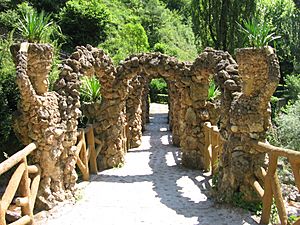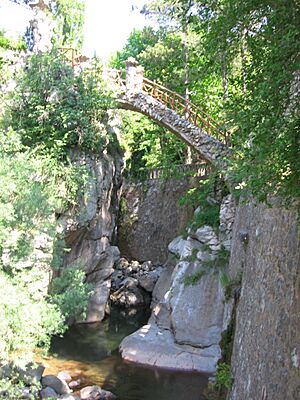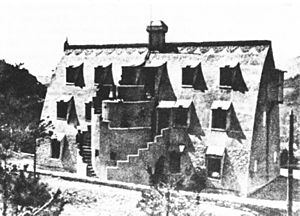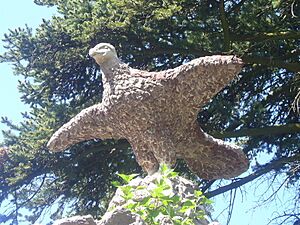Artigas Gardens facts for kids
Quick facts for kids Artigas Gardens |
|
|---|---|
 |
|
| Type | Public garden |
| Location | La Pobla de Lillet, Barcelona |
| Designer | Antoni Gaudí |
| Operated by | Reial Càtedra Gaudí |
| Open | Yes |
The Artigas Gardens (also known as Els Jardins de Can Artigas in Catalan) is a beautiful park located in La Pobla de Lillet, near Barcelona, Spain. This special garden was designed by the famous architect Antoni Gaudí between 1905 and 1906. Gaudí was known for his unique Modernista style, which means "modern" or "new style." Like many of his projects, these gardens are full of interesting arches and hidden Christian symbols.
For a long time, the gardens were almost forgotten. But in 1992, they were carefully restored. Today, you can visit and enjoy the amazing designs created by Gaudí and the sculptures by Ramon Millet i Domènech.
Contents
Discovering the Artigas Gardens
How the Gardens Were Designed
In 1905, Gaudí visited Lillet to build a mountain house called the Catllaràs chalet. This house was for engineers working at a coal mine. The mine supplied a cement factory owned by Eusebi Güell. Güell was a very rich businessman and Gaudí's main supporter, meaning he paid for many of Gaudí's projects.
While in Lillet, Gaudí stayed with a textile businessman named Joan Artigas i Alart. Mr. Artigas had a large property called Font de la Magnèsia next to the Llobregat river. As a thank you for Mr. Artigas's kindness, Gaudí designed these beautiful gardens for him.
Gaudí had already worked on a similar, but smaller, project at Park Güell in Barcelona. He even sent some of the workers from Park Güell to Lillet. This is why the Artigas Gardens look a bit like Park Güell. Gaudí made sure the gardens blended perfectly with the nature around them. He also built a cool artificial cave, which was one of his favorite design ideas. He had designed a similar cave for a waterfall in Parc de la Ciutadella.
Special Features and Hidden Meanings
Gaudí designed the gardens so that visitors would follow a path and discover different interesting spots:
- La Glorieta: This is a higher spot that offers great views of the gardens.
- La Cova: This cave was the original location of the Font de la Magnèsia (a spring). Gaudí used special curved arches here, which were a common feature in his buildings.
- La Cascada: This is a stone fountain decorated with a mosaic style called "trencadís". It has plant shapes made from concrete.
- El Berenador: This area is next to the Arch Bridge. You can see two human figures here, one male and one female. Along the Glorieta path, you'll also spot twisted snake shapes made from a type of rock called conglomerate.
Like many of his works, Gaudí filled the Artigas Gardens with Christian symbols. For these gardens, he used symbols from the four gospels, which are books in the Christian Bible. You can find images of four special creatures, called Tetramorphs, throughout the park:
- An angel representing Saint Matthew at La Cascada.
- An eagle representing Saint John at the Coix arch bridge. This bridge crosses the Llobregat river.
- A lion representing Saint Mark at La Pèrgola.
- A bull representing Saint Luke at the Bull Fountain.
These four symbols are placed in a way that forms a cross shape.
Bringing the Gardens Back to Life
By the end of 1971, the Artigas Gardens were almost completely abandoned. Then, an article was published that revealed Gaudí had designed them. This brought attention back to the gardens. In 1992, they were carefully restored under the guidance of the Reial Càtedra Gaudí. The sculptures you see today were created by Ramon Millet i Domènech. The gardens are now owned by the local town and are open for everyone to visit and enjoy.
Gallery
See also
 In Spanish: Jardines de Can Artigas para niños
In Spanish: Jardines de Can Artigas para niños
- Catalan Modernisme
- Pergola







